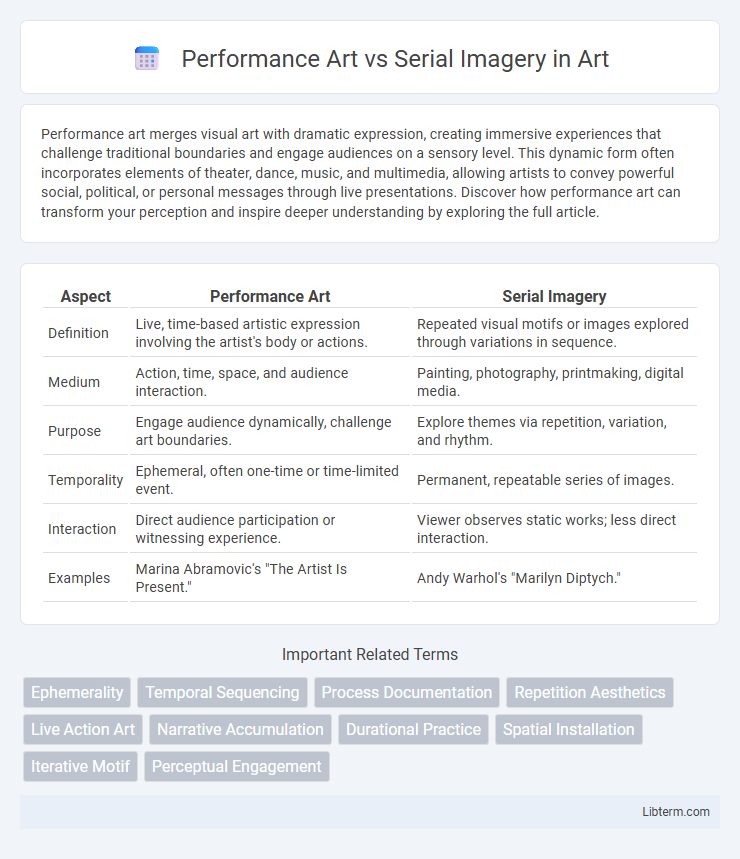Performance art merges visual art with dramatic expression, creating immersive experiences that challenge traditional boundaries and engage audiences on a sensory level. This dynamic form often incorporates elements of theater, dance, music, and multimedia, allowing artists to convey powerful social, political, or personal messages through live presentations. Discover how performance art can transform your perception and inspire deeper understanding by exploring the full article.
Table of Comparison
| Aspect | Performance Art | Serial Imagery |
|---|---|---|
| Definition | Live, time-based artistic expression involving the artist's body or actions. | Repeated visual motifs or images explored through variations in sequence. |
| Medium | Action, time, space, and audience interaction. | Painting, photography, printmaking, digital media. |
| Purpose | Engage audience dynamically, challenge art boundaries. | Explore themes via repetition, variation, and rhythm. |
| Temporality | Ephemeral, often one-time or time-limited event. | Permanent, repeatable series of images. |
| Interaction | Direct audience participation or witnessing experience. | Viewer observes static works; less direct interaction. |
| Examples | Marina Abramovic's "The Artist Is Present." | Andy Warhol's "Marilyn Diptych." |
Introduction to Performance Art and Serial Imagery
Performance art emphasizes live, time-based experiences where the artist's body, movement, and presence engage directly with the audience, often challenging traditional art forms. Serial imagery involves a sequence of related images that explore variation, repetition, and progression within a visual narrative, emphasizing conceptual continuity and formal experimentation. Both forms reflect contemporary art's interest in temporality and process but diverge in their use of the artist's presence and visual sequencing to convey meaning.
Historical Context and Evolution
Performance art emerged in the 1960s as a radical form challenging traditional art boundaries, emphasizing the artist's body and live actions within social and political contexts. Serial imagery, rooted in early 20th-century avant-garde movements and popularized by artists like Andy Warhol, investigates repetition and variation to explore themes of mass production and consumer culture. Both forms evolved as responses to changing technological and cultural landscapes, reflecting shifts in artistic intention from ephemeral encounters to critiques of media saturation.
Defining Performance Art: Key Characteristics
Performance art is characterized by live, time-based presentations that emphasize the artist's body and actions as the central medium, often blurring the line between performer and audience. It prioritizes ephemeral experiences, spontaneity, and direct interaction, contrasting with static art forms like painting or sculpture. This art form challenges traditional narratives by incorporating elements of theater, dance, and visual art to create immersive, multi-sensory events.
Exploring Serial Imagery: Core Concepts
Serial imagery centers on the repetition and variation of visual elements to explore temporal sequences and narrative progression within art. It emphasizes continuity and change by presenting multiple frames or moments, often challenging static representation through dynamic visual rhythms. This approach contrasts with performance art's emphasis on live, ephemeral events by focusing on structured visual documentation and thematic development across a series of images.
Mediums and Materials: Differences and Similarities
Performance art primarily utilizes the human body, space, and time as its mediums, emphasizing live actions and interactions that unfold in real-time. Serial imagery, often found in photography, painting, or digital art, relies on repeated visual motifs or sequences across multiple frames or canvases to explore variation and narrative continuity. Both practices experiment with temporality and viewer perception, yet performance art is ephemeral and experiential, while serial imagery produces tangible, enduring artifacts.
Audience Engagement and Experience
Performance Art emphasizes direct, immersive audience engagement by often involving viewers as active participants, creating a dynamic and unrepeatable experience. Serial Imagery, characterized by repeated visual motifs or sequences, invites reflective observation, encouraging the audience to discern patterns and explore thematic variations over time. The experiential contrast lies in Performance Art's immediate, embodied interaction versus Serial Imagery's contemplative, cumulative engagement.
Temporal vs. Spatial Elements
Performance Art emphasizes temporal elements through live actions and real-time audience interaction, creating an ephemeral experience that unfolds over a specific duration. Serial Imagery prioritizes spatial elements by presenting a sequence of related images simultaneously or in a controlled arrangement, enabling viewers to analyze visual variations across space rather than time. The contrast between these forms lies in Performance Art's dynamic temporality versus Serial Imagery's fixed spatial structure, impacting how narrative and meaning are perceived.
Intent and Message: Artistic Goals
Performance art prioritizes real-time interaction and embodying concepts through physical presence, aiming to create immersive, experiential messages that challenge audience perceptions. Serial imagery focuses on repetition and sequence to explore themes such as time, change, or narrative progression, using visual continuity to convey complex artistic intentions. Both mediums utilize distinct methods to provoke thought and evoke emotional responses aligned with their specific creative objectives.
Notable Artists and Influential Works
Performance art pioneers like Marina Abramovic revolutionized the medium with groundbreaking works such as "The Artist is Present," emphasizing live interaction and physical presence. In contrast, serial imagery is exemplified by artists like Andy Warhol, whose repeated prints in pieces like "Campbell's Soup Cans" explore themes of mass production and consumer culture. Both forms challenge traditional art boundaries, with Abramovic's intense endurance art contrasting Warhol's critique of commodification through repetition.
Contemporary Impact and Future Trends
Performance art challenges traditional visual boundaries by engaging audiences through live, immersive experiences that emphasize temporality and presence, significantly influencing contemporary art practices. Serial imagery, characterized by repeated or sequential visuals, explores themes of variation, time, and narrative, shaping digital and multimedia art trends with its systematic approach to image production. Emerging technologies like virtual reality and AI are blurring distinctions between performance art and serial imagery, suggesting future artistic expressions will hybridize real-time interaction with algorithmic visual sequences.
Performance Art Infographic

 libterm.com
libterm.com